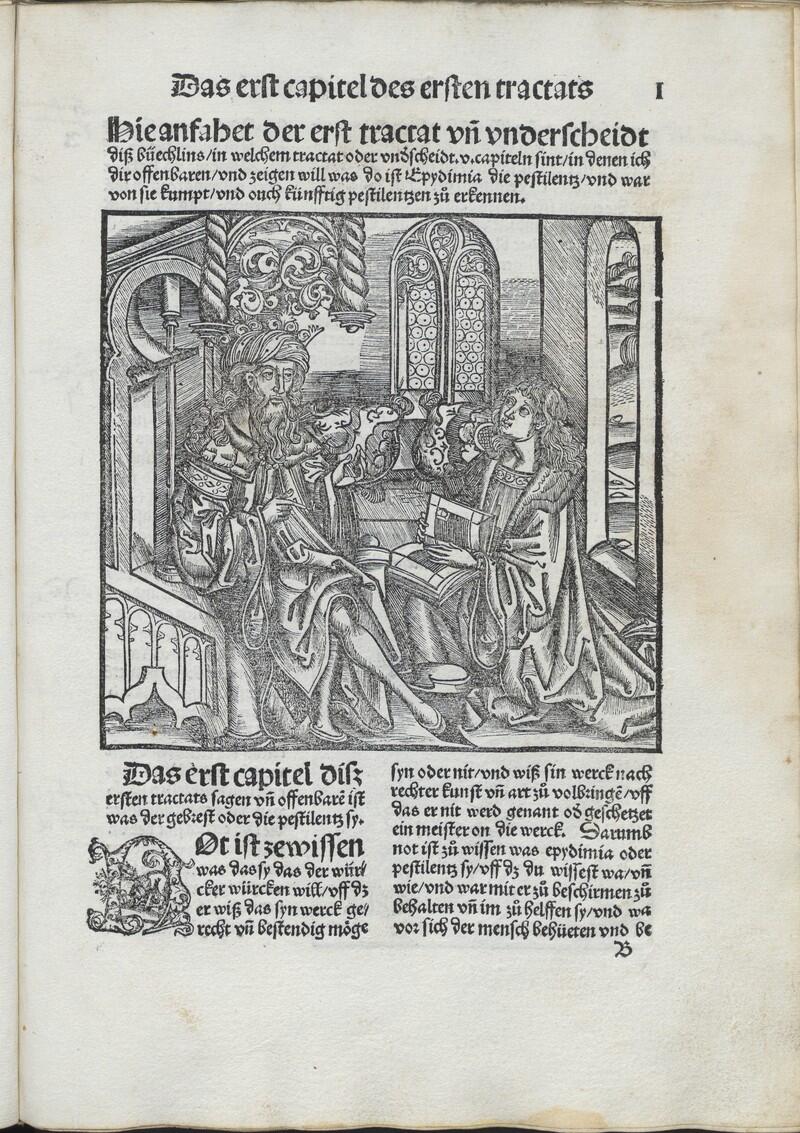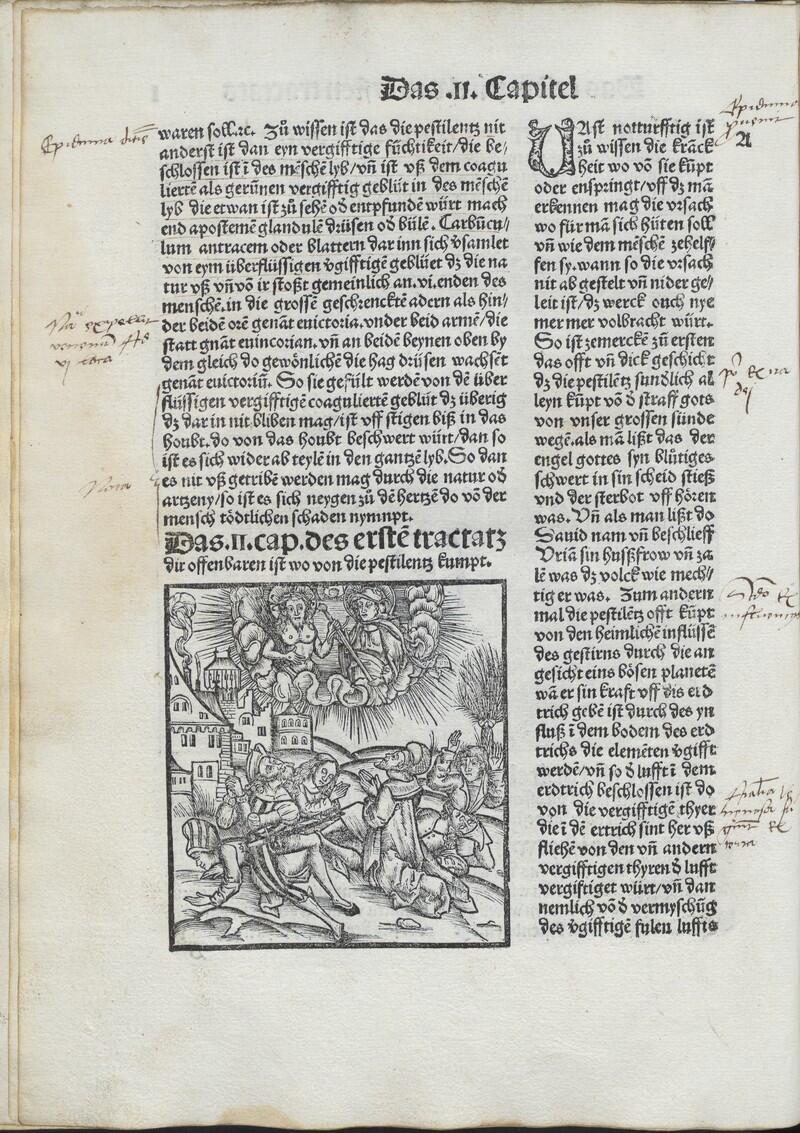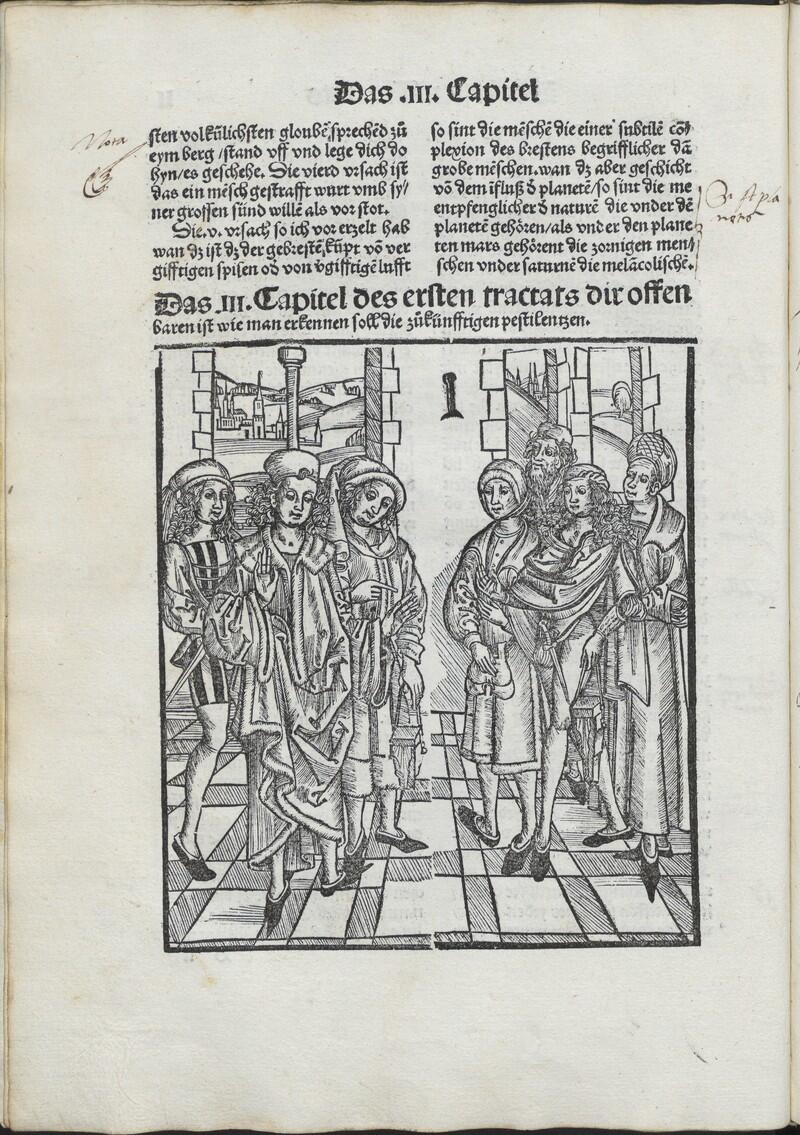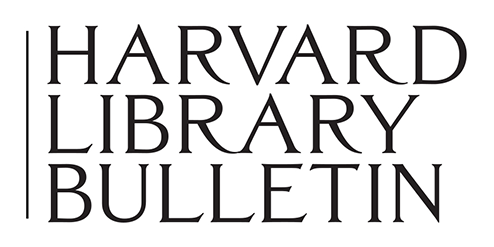Hieronymus Brunschwig, Liber pestilentialis (Strassburg, 1500)
Francis A. Countway Library of Medicine, Rare Books, Ballard 235
Translation
The First Chapter of this First Book, in which it is said and revealed what the infirmity or pestilence is.
It is necessary to know what the artisan wants to create in order to know whether his work is correct and suitable or not and [whether he] knows how to create his work following the proper art and skill, as he will not be called or thought a master without the work. Similarly, it is necessary to know what epidemia or pestilence is, so that you know what, and how, and with what to defend and help against it and from what a person should protect and preserve himself, etc. You should know that the pestilence is nothing else but a poisonous moisture that is enclosed in the human body, and it emerges from the body from both coagulated and fluid blood, as sometimes can be seen or discovered making abscesses, glands, or boils, carbuncular swellings or pox, in which an excess of poisoned blood collects. Nature usually throws [this blood] away from a person on six extremities: in the large, constricted arteries, as behind both ears, named enictoria; under both arms, named evincorian; and at the top of both legs by where the testicles usually grow, named evictorium. After they are filled with the excess poisoned coagulated blood, the remnant that cannot fit is raised into the head, from which the head is troubled, and so follows other parts down the whole body. If it is not driven out by nature or medicine, it is likely that the person’s heart will experience lethal harm.
The Second Chapter of the First Book, in which it is revealed from whence the pestilence comes.
To know the disease, it is very necessary to know from whence it comes or arises, so that one can recognize the cause from which one should protect oneself and how a person can be helped. Thus if the cause is not cut off or quashed, the work will also never be completed. First it should be noted that it often happens that pestilence comes solely and especially from God’s punishment for our great sins, just as one reads that David took and slept with Uriah’s housewife and counted how many people were in his legions. Secondly the pestilence often comes from the secret influence of the stars through the face of an evil planet. When it exerts its power on the earth, the element is poisoned through the influx in the earth’s ground, and thus air is trapped in the ground, from which subterraneous poisonous animals flee. From them and other poisonous animals, the air is poisoned, and then the mixture of foul, poisonous air and the moisture of the earth saturates the soil where herbs and fruit grow, from which the people and animals who eat it are poisoned, from which that water that flows through the earth is poisoned, which poisons the people and animals who drink it. I recommend that you recognize and reveal this influence of the stars, the astronomis. Third, if a person eats too much fruit or unripe food and gets too full of food and drink, as commonly happens after a drought, when people eat all food good and bad—if then the stomach cannot digest such food, it will be full in the person’s body and become poison, which causes illness. The same things happens if a person inhales poisonous air into his lungs with his breath, which happens sometimes with large effect if dead bodies are left lying on the ground, from which the air is poisoned. It also comes from other visible things, as Hippocrates says, of quick and great reversal of the seasons, such as when the summer is too cold and moist and the winter much too warm, the same if spring and autumn do not have their natural potency…
Commentary
Introduction
Hieronymus Brunschwig’s Book on the Poison of Pestilence (Liber pestilentialis, 1500) provides German readers with a work on the diagnosis and treatment of plague. Brunschwig (c. 1450–1512) came from the artisan classes in the city of Strasbourg, a free imperial city of the Holy Roman Empire. He practiced as a surgeon and ran an apothecary shop on the Strasbourg market square, in addition to being a popular author. His first book provided a handbook for surgeons (Cirurgia, 1497), and he also wrote two separate books on distilled medicines, published in 1500 and 1512.[1] All of his works were published with the press of Johann Grüninger, with the prolific illustrations that were a hallmark of Grüninger’s press (figs. 1–2).


Indeed, many of the illustrations were shared between Brunschwig’s various books, and the woodblocks had detachable pieces and plugs that allowed the press to mix and match the images.[2] A visible dividing line can be seen in fig. 3 (below). Most of the images portray general scenes of healing rather than depicting plague specifically. The Liber pestilentialis is quite substantial at 36 folios (72 pages) long. Brunschwig divided it into five books, with multiple chapters in each book, covering the cause, diagnosis, prevention, and treatment of plague.

Brunschwig wrote the Liber pestilentialis to explain plague to a German-reading public. He aimed the treatise at non-physicians, noting that “many people” had asked him to write a short tract on plague “for the whole citizenship,” since “long materials are often difficult for the reader and student to understand.” He addressed it especially to other medical artisans, particularly “young aspiring master surgeons and barbers,” who were expected to treat the external symptoms of plague. Brunschwig made it clear that he was not excluding physicians from his intended readership out of disrespect, but rather because “I wanted to spare them, as they have much greater and better things to do.” At the same time, he highlighted the propensity of physicians to escape plague-stricken cities for their own self-preservation. In a 1473 plague epidemic in an unnamed city, he stated, “I, Hieronymus, have read and have also seen two or three times that the most famous physicians of this city fled” during bouts of plague. Although he hastened to mention that physicians “nowadays” would never do such a thing, he insisted that “this illness does not just belong to the physician, but also to the surgeon.”[3] As was common in all of his books, he included metaphors of artisanship and handiwork throughout the work.[4]
Plague, Poison, and Print
One of Brunschwig’s underlying assumptions throughout the Liber pestilentialis is a connection between plague and poison. His full title, Book on the Poison of Pestilence, makes that link explicit. The idea of plague as a poison originated in the first years of the Black Death, 1347–51, when the large numbers of people dying from plague made physicians scramble for an explanation. At the time, most physicians subscribed to the humoral theory of disease, an individualized system based on each person’s particular balance of humors. Disease did not come from an external disease agent, but rather an internal imbalance; there was no developed theory of contagion. Epidemic disease was usually explained by environmental conditions. When the Black Death swept through, however, people of all types perished—young, old, men, women, sanguine, choleric, melancholic, phlegmatic—and at such great rates that the usual explanations appeared insufficient. Many physicians still used humoral theory to explain plague, usually positing a conjunction of evil planets that caused natural catastrophes leading to massive environmental changes that affected the humors. Some, however, saw similarities to poison in the way plague affected the body, in the severity of symptoms and the short time between disease onset and death.[5]
In the early plague epidemic, the disease often was blamed on poison put in drinking water by lepers or, more commonly, Jews.[6] Physicians, however, also turned to poison as an explanation for the way plague affected the body. Poison worked differently from other substances. As historian Fredrich Gibbs has shown, it could function either by radically affecting the humors, or through an occult mechanism called “total substance” or “specific form.”[7] The latter theory posited that the whole substance of the poison affected the whole substance of the body, and especially the heart, allowing small amounts to cause great harm to people of all different humoral complexions. In the case of plague, many physicians described poisonous vapors released into the air by a catastrophe, such as an earthquake. The Florentine physician Gentile da Foligno (d. 1348) argued that corrupt air generated a poisonous matter near the lungs and heart, which caused the symptoms of the disease. Increasingly, plague came to be seen as a poisonous illness, and many standard remedies for poison were recommended for plague.[8]
Brunschwig’s Liber pestilentialis was part of a burgeoning genre of printed German-language treatises on plague, often aimed at the “common man” or at specific non-Latinate practitioners like surgeons or barbers. As Erik Heinrichs has noted, these pamphlets began appearing in the 1470s, usually written by German town physicians, although the Nuremberg surgeon Hans Folz published a plague treatise in 1482.[9] Brunschwig borrowed parts of his book liberally from Heinrich Steinhöwel, a physician in Ulm, whose 1473 plague treatise was reprinted several times and who also wrote for a broad audience.[10] However, Brunschwig’s book is far longer and places a far greater emphasis on poison. German-language plague literature circulated in manuscript long before pamphlets began to be printed, and although he could not read Latin, Brunschwig was clearly familiar with works of many medical authorities. In addition to Steinhöwel, he cites Hippocrates, Avicenna, Galen, and Gentile da Foligno, among others.
Book 1, Chapters 1–2
The notion of poison as a cause of disease, paired with Brunschwig’s background as an artisan-author, is helpful in understanding the text translated here. These chapters begin the first book, in which Brunschwig describes the origin and causes of plague. The first chapter opens with an artisanal metaphor and includes a brief discourse on how the poisonous matter of plague works inside the body. He focuses particularly on how the poison causes external eruptions, a theme particularly important to surgeons and barbers, who were responsible for treating conditions on the outside of the body (in contrast to physicians, who were responsible for internal conditions). In keeping with the general thought of the time, Brunschwig entertains a variety of causes of plague, including punishment from sin. His discussion of cause in chapter 2, however, mainly focuses on the different ways the earth can produce poison. It is interesting to contemplate why poison provided such a useful disease framework for an artisan like Brunschwig. There was a widespread understanding of poison as a harming agent across all classes in late medieval Europe and a corresponding fear of it. Brunschwig, who clearly favored a naturalistic etiology over a religious one, may have found poison the most comprehensible explanation for plague’s indiscriminate mortality. In any case, his Liber pestilentialis provides fascinating evidence that the connection between plague and poison in the writings of scholarly physicians also resonated among the artisan classes.
Provenance of the Countway Library Copy
This copy of the Liber pestilentialis is from the William Norton Bullard collection, originally donated to the Boston Medical Library. The inside cover has the beautiful bookplate of a previous owner, Baron Ferdinand Hoffman von Grünpichl-Stechau (1540–1607), an avid book collector and bibliophile who owned over 4,000 books at the time of his death. Underneath Hoffman’s bookplate is a fragment of a 13th-century vellum manuscript used as a pastedown, which helps keep the pages of the book in place (fig. 4, below).[11] Either Hoffman or another reader has added copious marginal notations throughout the book, mostly in Latin. The marginalia highlight the topics discussed and act as a guide through the book. There are a number of manicules (pointing hands) highlighting statements of particular interest.[12] Despite Brunschwig’s stated audience of German-reading artisans, his book was clearly of interest to Latinate readers as well.

Notes
[1] Hieronymus Brunschwig, Cirurgia, Handwerckung der Wundartzny (Strasbourg, 1497); Liber de Arte Distillandi de Simplicibus (Strasbourg: Johan Grüninger, 1500); Liber de arte distillandi de compositis (Strasbourg, 1512). For historical work on Brunschwig, see especially Tillman Taape, “Hieronymus Brunschwig and the Making of Vernacular Medical Knowledge in Early German Print” (Ph.D. thesis, Cambridge, UK, Pembroke College, University of Cambridge, 2017); “Common Medicine for the Common Man: Picturing the ‘Striped Layman’ in Early Vernacular Print,” Renaissance Quarterly 74 (2021): 1–58; Alisha Rankin, “How to Cure the Golden Vein: Medical Remedies as Wissenschaft in Early Modern Germany,” in Ways of Making and Knowing: The Material Culture of Empirical Knowledge, ed. Pamela H. Smith, Amy R. W. Meyers, and Harold J. Cook (Ann Arbor: University of Michigan Press, 2014), 109–33; Henry E. Sigerist, A Fifteenth Century Surgeon: Hieronymus Brunschwig and His Work (New York: Ben Abramson, 1946).
[2] Taape, “Hieronymus Brunschwig,” 214–29; “Common Medicine for the Common Man,” 27.
[3] Hieronymus Brunschwig, Liber pestilentialis de venenis epidimie (Strassburg, 1500), A3r.
[4] Taape, “Hieronymus Brunschwig,” 200–37.
[5] Frederick W. Gibbs, Poison, Medicine, and Disease in Late Medieval and Early Modern Europe (Abingdon, UK: Routledge, 2019), 116–41; Jon Arrizabalaga, “Pestis Manufacta: Plague, Poisons and Fear in Mid-Fourteenth-Century Europe,” in “It All Depends on the Dose”: Poisons and Medicines in European History, ed. Ole Peter Grell, Andrew Cunningham, and Jon Arrizabalaga (Abingdon, UK: Routledge, 2018), 62–80.
[6] On this topic, see especially Samuel K. Cohn, “The Black Death and the Burning of Jews,” Past & Present no. 196 (2007): 3–36; Klaus Bergdolt, “Die Pest Und Die Juden - Mythen, Fakten, Topoi,” Aschkenas: Zeitschrift Für Geschichte Und Kultur Der Juden 29, no. 1 (2019): 43–62, https://doi.org/10.1515/asch-2019-0004; Kay Peter Jankrift, “Judenpogrome in rheinischen und westfälischen Städten im Umfeld des Schwarzen Todes,” Aschkenas 16, no. 2 (2008): 545–60, https://doi.org/10.1515/ASCH.2008.545.
[7] Frederick W. Gibbs, “Poisonous Properties, Bodies, and Forms in the Fifteenth Century,” Preternature 2 (2013): 19–46; Poison, Medicine, and Disease.
[8] Gibbs, Poison, Medicine, and Disease, 116–41; Alisha Rankin, The Poison Trials: Wonder Drugs, Experiment, and the Battle for Authority in Renaissance Science (Chicago: University of Chicago Press, 2021), 43–46.
[9] Erik A. Heinrichs, Plague, Print, and the Reformation: The German Reform of Healing, 1473–1573 (London: Routledge, 2018).
[10] Heinrich Steinhöwel, Undanckbarkeit (alsz die altern wÿsen schreiben) ist für andere laster zeschelten... (Ulm, 1473); Heinrichs, Plague, Print, and the Reformation, 24–25.
[11] Hoffman’s library was eventually auctioned off in 1933, but Bullard, who died in 1931, must have acquired this volume before the library was dissolved. Hannes P. Naschenweng, “Die Burg Stechau und ihr Besitzer bis 1629,” Sonderbände der Zeitschrift des Historischen Vereines für Steiermark 24 (1997): 3–42.
[12] On marginalia, see especially William H. Sherman, Used Books: Marking Readers in Renaissance England, Material Texts (Philadelphia: University of Pennsylvania Press, 2008).
